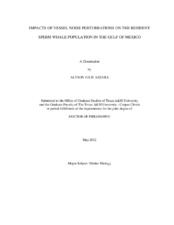| dc.contributor.advisor | von Zharen, Wyndylyn | |
| dc.creator | Azzara, Alyson | |
| dc.date.accessioned | 2012-07-16T15:58:00Z | |
| dc.date.accessioned | 2012-07-16T20:28:28Z | |
| dc.date.available | 2014-09-16T07:28:20Z | |
| dc.date.created | 2012-05 | |
| dc.date.issued | 2012-07-16 | |
| dc.date.submitted | May 2012 | |
| dc.identifier.uri | https://hdl.handle.net/1969.1/ETD-TAMU-2012-05-10888 | |
| dc.description.abstract | The Gulf of Mexico is home to two of the world?s ten busiest ports by cargo volume, the Port of New Orleans and the Port of Houston; and in 2008, these ports hosted a combined 14,000 ships, a number which is likely only to increase. Past research shows that this increase in shipping worldwide has historically lead to an increase in ambient noise level of 3-5dB per decade. Sperm whales in the Gulf of Mexico are considered a genetically distinct, resident population. They have a preference for the Louisiana-Mississippi Shelf region which directly overlaps with the entrance to the Mississippi and the Port of New Orleans. Disruptions from vessel noise could influence feeding and breeding patterns essential to the health of the stock. Data used in this analysis were collected continuously over 36 days in the summer of 2001 from bottom moored Navy Environmental Acoustic Recording System (EARS) buoys. Results showed a significant difference (P<0.05) in noise level between hours with ships passing and hours without. Metrics for 56 ship passages were analyzed to compare duration of ship passage with duration of maximum received level (MRL) during ship passage. Results of that analysis showed an average ship passage of 29 minutes with average MRL lasting 23% of the ship passage and an average increase of 40dB. Lastly, click counts were made with the Pamguard. Click counts for ship passages were completed for 35 min and 17.5 min before and after the estimated closest point of approach (CPA) for each ship. Results showed a 36% decrease in the number of detectable clicks as a ship approaches when comparing clicks detected at intervals of both 35 minutes before and 17 minutes before the CPA; additionally, 22% fewer clicks were counted 30 min after the ship than 30 min before (results significant at the P=0.01 level). These results indicate a potential change in sperm whale behavior when exposed to large class size vessel traffic (e.g. tankers and container ships) from major shipping lanes. Recommendations for addressing this issue are discussed. | en |
| dc.format.mimetype | application/pdf | |
| dc.language.iso | en_US | |
| dc.subject | Sperm whales | en |
| dc.subject | Acoustics | en |
| dc.subject | Gulf of Mexico | en |
| dc.subject | Anthropogenic noise | en |
| dc.subject | Shipping | en |
| dc.subject | management | en |
| dc.subject | regulations | en |
| dc.title | Impacts of Vessel Noise Perturbations on the Resident Sperm Whale Population in the Gulf of Mexico | en |
| dc.type | Thesis | en |
| thesis.degree.department | Marine Biology | en |
| thesis.degree.discipline | Marine Biology | en |
| thesis.degree.grantor | Texas A&M University | en |
| thesis.degree.name | Doctor of Philosophy | en |
| thesis.degree.level | Doctoral | en |
| dc.contributor.committeeMember | Wursig, Bernd | |
| dc.contributor.committeeMember | Peterson, Tarla | |
| dc.contributor.committeeMember | Randall, Robert | |
| dc.type.genre | thesis | en |
| dc.type.material | text | en |
| local.embargo.terms | 2014-07-16 | |


